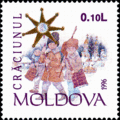Epiphany (holiday) facts for kids
Epiphany is a Christian holiday or festival celebrated every year on January 6. It's a special day that remembers when Jesus was shown to the world. The main part of the celebration is about the Magi, also known as the Three Wise Men or Three Kings. They followed a bright star to Bethlehem to visit baby Jesus. This story is found in the Gospel of Matthew, chapter 2, in the Bible.
Contents
What is Epiphany?
Epiphany is a Greek word that means "showing" or "revealing." For Christians, it's a time to celebrate that Jesus was revealed not just to the Jewish people, but to everyone. The visit of the Magi, who were not Jewish, shows that Jesus came for all people around the world.
The Story of the Magi
The Magi were wise men, possibly kings or astrologers, from the East. They studied the stars and knew that a new, special star meant a new king had been born. They traveled a long way, following this star, to find the baby Jesus. When they found him, they gave him three very special gifts:
- Gold: A gift for a king.
- Frankincense: A sweet-smelling resin (like tree sap) used in religious ceremonies, showing Jesus's divine nature.
- Myrrh: Another resin used for embalming (preparing bodies for burial), hinting at Jesus's future death and resurrection.
Their visit is a key part of the Epiphany celebration.
How Epiphany is Celebrated
People celebrate Epiphany in many different ways around the world. Many traditions involve light, water, and special foods.
Special Traditions
- King Cakes: In some countries, like France, Spain, and parts of the United States, people eat a special "King Cake." A small toy or bean is hidden inside. Whoever finds it in their slice becomes the "king" or "queen" for the day and wears a crown.
- Star Singers: In countries like Germany and Austria, groups of children dress up as the Magi. They go from house to house, singing songs and collecting money for charity. They often write "K+M+B" and the year (like "2024") on the doorframes with chalk. This stands for "Christus Mansionem Benedicat," which means "May Christ Bless this House." It's sometimes mistakenly thought to stand for the names of the Magi: Caspar, Melchior, and Balthasar.
- Water Blessings: In Eastern Orthodox Christian churches, Epiphany is called "Theophany," meaning "appearance of God." It celebrates Jesus's baptism in the Jordan River. Priests bless large bodies of water, like rivers, lakes, or the sea. Sometimes, a cross is thrown into the water, and people jump in to retrieve it, even if the water is very cold! This is a symbol of cleansing and renewal.
- Parades and Gifts: In Spain and Latin American countries, Epiphany is often when children receive gifts, rather than on Christmas Day. There are often colorful parades with people dressed as the Three Kings, throwing candy to children.
Epiphany Around the World
Epiphany is celebrated in different ways depending on the country and Christian tradition:
- In Spain and Mexico, it's known as Día de Reyes (Day of the Kings).
- In Italy, a good witch named La Befana is said to bring gifts to children on Epiphany Eve.
- In Ethiopia, the celebration is called Timkat and involves large, colorful processions and re-enactments of Jesus's baptism.
- In Bulgaria and Greece, the blessing of the waters and the retrieval of the cross from icy rivers are major events.
Epiphany marks the end of the Christmas season for many Christians. It's a time to remember the journey of the Magi and the message that Jesus came for everyone.
Images for kids
-
Adoration of the Magi by Bartolomé Esteban Murillo, 17th century
-
Adoration of the Magi by El Greco, 1568, Museo Soumaya, Mexico City
-
The Three Magi: Balthasar, Melchior, and Gaspar, from a late-6th-century mosaic at the Basilica of Sant'Apollinare Nuovo in Ravenna, Italy
-
Theophany Crucession in Bulgaria. The priests are going to throw a wooden cross in the Yantra river. Believers will then jump into the icy waters to recover the cross.
-
Greek Orthodox bishop at the Great Blessing of Waters on Theophany, releasing the cross off the Glenelg Jetty, South Australia, for one of the swimmers below to retrieve
-
A traditional Bulgarian all-male horo dance in ice-cold water on Theophany
-
Orthodox priests dancing during the celebration of Timkat
-
Star singers visit President Karl Carstens (1982).
-
Epiphany procession in the capital of North Macedonia Skopje near Stone Bridge on the Vardar river in the early 1920s
-
King cakes of the type locally called "French style" on display at the chain bakery/restaurant "La Madeline" branch in Carrollton, New Orleans. They come with cardboard "crowns" to be worn by whoever gets the slice with the token and becomes monarch of the event.
See also
 In Spanish: Epifanía para niños
In Spanish: Epifanía para niños


















